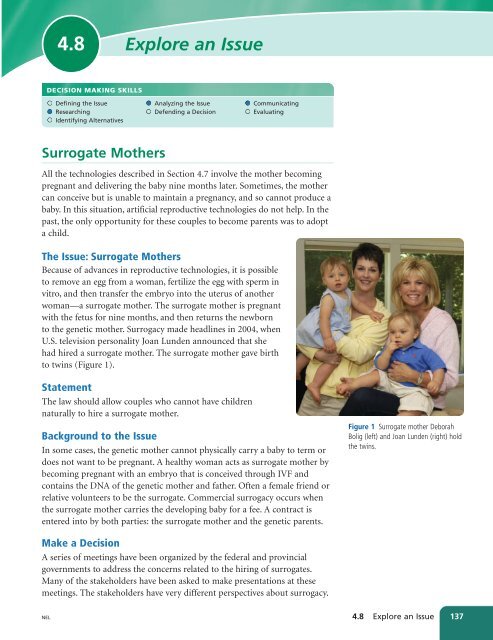Unit A Reproduction
Unit A Reproduction
Unit A Reproduction
You also want an ePaper? Increase the reach of your titles
YUMPU automatically turns print PDFs into web optimized ePapers that Google loves.
4.8<br />
Explore an Issue<br />
DECISION MAKING SKILLS<br />
Defining the Issue<br />
Researching<br />
Identifying Alternatives<br />
Analyzing the Issue<br />
Defending a Decision<br />
Communicating<br />
Evaluating<br />
Surrogate Mothers<br />
All the technologies described in Section 4.7 involve the mother becoming<br />
pregnant and delivering the baby nine months later. Sometimes, the mother<br />
can conceive but is unable to maintain a pregnancy, and so cannot produce a<br />
baby. In this situation, artificial reproductive technologies do not help. In the<br />
past, the only opportunity for these couples to become parents was to adopt<br />
a child.<br />
The Issue: Surrogate Mothers<br />
Because of advances in reproductive technologies, it is possible<br />
to remove an egg from a woman, fertilize the egg with sperm in<br />
vitro, and then transfer the embryo into the uterus of another<br />
woman—a surrogate mother. The surrogate mother is pregnant<br />
with the fetus for nine months, and then returns the newborn<br />
to the genetic mother. Surrogacy made headlines in 2004, when<br />
U.S. television personality Joan Lunden announced that she<br />
had hired a surrogate mother. The surrogate mother gave birth<br />
to twins (Figure 1).<br />
Statement<br />
The law should allow couples who cannot have children<br />
naturally to hire a surrogate mother.<br />
Background to the Issue<br />
In some cases, the genetic mother cannot physically carry a baby to term or<br />
does not want to be pregnant. A healthy woman acts as surrogate mother by<br />
becoming pregnant with an embryo that is conceived through IVF and<br />
contains the DNA of the genetic mother and father. Often a female friend or<br />
relative volunteers to be the surrogate. Commercial surrogacy occurs when<br />
the surrogate mother carries the developing baby for a fee. A contract is<br />
entered into by both parties: the surrogate mother and the genetic parents.<br />
Figure 1 Surrogate mother Deborah<br />
Bolig (left) and Joan Lunden (right) hold<br />
the twins.<br />
Make a Decision<br />
A series of meetings have been organized by the federal and provincial<br />
governments to address the concerns related to the hiring of surrogates.<br />
Many of the stakeholders have been asked to make presentations at these<br />
meetings. The stakeholders have very different perspectives about surrogacy.<br />
NEL<br />
4.8 Explore an Issue 137

















